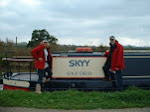When we awoke the rain was still hammering on the hull, another duff forecast, but by the time we were ready to cast off the rain stopped and gradually the sun won the battle with the clouds and the month of May did its belated best to redeem itself.
It didn’t take long to reach The Macclesfield’s junction with The Trent & Mersey, but first we passed under two Snake Bridges. These bridges were designed so that when the towpath changed from one side of the canal to the other, the horse towing the boat could do so without having to unhitch. A local dog walker said that locally they were called Snail Bridges, but this elegant design is also called, Turnover or Changeling Bridges.
Just before the junction is the pretty Hall Green stop lock, this was to prevent precious water flowing from the Macclesfield into The T & M canal. The junction is an unusual arrangement as first the Macclesfield crossed the T & M on an aqueduct before executing a ninety degree turn and running parallel with the T & M bypassing two of its locks before joining with it.
A few yard further and we arrived at the entrance to the Harecastle Tunnel. There was just one boat waiting ahead of us as the Tunnel Keeper briefed us. If we should break down, then we must sound one long blast on our hooter every thirty seconds until we hear three short blasts in return, if we hadn’t managed to exit the tunnel after one hour and fifteen minutes they would send in the tug, however we had no intention of breaking down. The estimated time from start to finish traveling the 2926yds. was forty five minutes at a steady three to four MPH. But in fact we were out the other end in thirty five minutes. There is a door over the exit which is only drawn back as we approached; this is to enable the fume extraction system to function more effectively and as we exited it looked like that we had just driven out of a garage with accommodation over, weird!
The photos clearly show another tunnel entrance, this was the original tunnel that took eleven years to dig, opening in 1777, but forty five years later the bottle-neck to traffic was so great that it was decided to dig another one, this time it only took three years to complete allowing two way traffic. The original tunnel has since had to be abandoned as coal mining in the area had caused it to subside, but as all the traffic now is leisure and self propelled the one tunnel is sufficient.
The fact that we were now in the pottery area of Stoke on Trent was very apparent when the first brick built bottle kiln came into view, they really do look like milk bottles, Most of them have disappeared and the remaining ones are preserved, but not used. Pottery is still what this area is all about so we moored a little way before the festival marina, determined over the next couple of days to investigate.








1 comment:
Hi both,
Enjoy the Potteries (Stoke-on-Trent) it is our home town - though we haven't lived there since 1969!
The best pot-bank (Stoke for pottery factory) to see is with a bottle kiln is Gladston Pottery in the town of Longton and a visit to the Wedgwood Factory at Barlaston is a must and we've always enjoyed good meals at the Plume of Feathers there and the Woolpack at Weston does a good steak!
Regards
Carol and George
Post a Comment